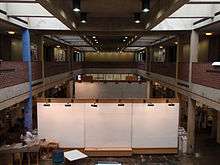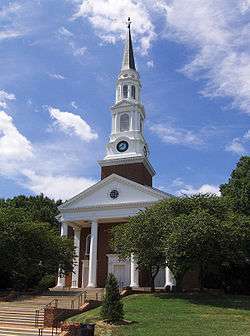University of Maryland School of Architecture
| Type | Public |
|---|---|
| Established | 1964 |
| Dean | Sonia Hirt |
| Location |
College Park, Maryland, United States 38°59′3″N 76°56′52.5″W / 38.98417°N 76.947917°W |
| Campus | Suburban |
| Website | http://www.arch.umd.edu/ |
The School of Architecture, Planning & Preservation is one of thirteen schools at the University of Maryland, College Park and operates six different programs: Architecture, Urban Studies and Planning, Historic Preservation, Real Estate Development, the Ph.D. program in Urban and Regional Design and Planning, the National Center for Smart Growth Research and Education,[1] and the Colvin Institute of Real Estate Development.
The school is located seven miles from downtown Washington, DC, and is also close to Baltimore and Annapolis.
History
In the 1960s, the University of Maryland invited the American Institute of Architects to help form a blue-ribbon committee to advise it on the establishment of an architectural school. The committee concluded in 1964 with a recommendation that an architecture program be established and located at College Park. In 1967, John Hill was appointed the first Dean of the School of Architecture, and the school opened to students that fall. In its initial years the program offered a five-year B.Arch Degree program, with the intention that a graduate degree program be initiated at a later date.
In 1972, the school moved into its present building and gained full accreditation. During the next few years, the school continued to develop its program and expand its areas of research and service, and added the Master of Architecture degree. It also made efforts to recruit students from a wider geographical and social constituency.
In 1970, the accredited Masters in Community Planning was established as part of the School of Social Work and Community Planning at the University of Maryland at Baltimore (UMAB). The program remained in Baltimore until 1988, when Ken Corey, the director of the Institute for Urban Studies at the College Park campus, and Mel Levin, director of Community Planning in Baltimore, oversaw a transfer of the Community Planning program from Baltimore to College Park and a merger of the two programs, in which the three faculty members from UMAB joined with five faculty members at the Institute for Urban Studies at College Park to create a new urban planning program. The newly configured Masters of Community Planning/Institute for Urban Studies program was located in the College of Behavioral and Social Sciences and offered a Masters in Community Planning and M.A. and B.A. degrees in Urban Studies. The planning program continues to offer seminars and an annual studio in Baltimore.
In 1980 selective admissions were instituted in the Architecture program, with students admitted to the pre-professional architecture program beginning in their junior collegiate years. The graduate professional degree program was fully accredited in 1985.
As part of the 1992 campus reorganization, the M.A. and B.A. degrees in Urban Studies were eliminated and the accredited Masters of Community Planning Program was moved from the College of Behavioral and Social Sciences to the School of Architecture. The urban planning program currently graduates approximately 25 students per year and has nine full-time faculty members.
During the 1980s, David Fogle, an architecture faculty member with an interest in historic preservation, oversaw the creation of a Certificate in Historic Preservation. In 2001, a full master's degree in historic preservation (HISP) evolved out of the certificate program and was incorporated into the School of Architecture. The Historic Preservation masters program now graduates approximately 12 students per year.
In 2000, the name of the School of Architecture was changed to the School of Architecture, Planning and Historic Preservation.
The National Center for Smart Growth Research and Education was established in 2001 as a cooperative venture of four academic units: Architecture, Planning, and Preservation; the School of Public Policy; the College of Agriculture and Natural Resources, and the A. James Clark School of Engineering. The center is headquartered in the School of Architecture, Planning, and Preservation, and focuses on research-based knowledge and education related to land use and growth management.
In 2002 the school began offering a Ph.D. in Urban and Regional Planning and Design, which admits a small number of Ph.D. candidates each year with interests related to the fields of urban design, social planning, urban policy, economic development, and transportation.
In 2006, a Masters program in Real Estate Development (MRED) was opened, which incorporates planning, design, preservation and smart growth knowledge, research, and strategies into its curriculum. In 2008, John and Karen Colvin gave $3 million, the largest donation in the school's history, to create the Colvin Institute of Real Estate Development, which is now the base for the Real Estate Development program.[2]
Campus and facilities

The School of Architecture, Planning and Preservation is located in the building of the same name on the south-western edge of the campus, next to the Robert H. Smith School of Business, which it has occupied since 1972.[3] The building includes studio space, classrooms, a lecture hall, the University of Maryland Architecture Library, and the Kibel Gallery. The Architecture Library contains 65,000 titles in the areas of architectural history, design, and theory, historic preservation, landscape architectural design, real estate development, and urban studies and planning.[4]
See also
References
- ↑ http://www.smartgrowth.umd.edu/
- ↑ "Developer gives $3M to launch 'green' real estate program", Washington Business Journal, February 5, 2008.
- ↑ arch.umd.edu, About the School Retrieved 2011-09-02.
- ↑ "About the Architecture Library". University of Maryland Libraries. Retrieved 5 October 2013.
